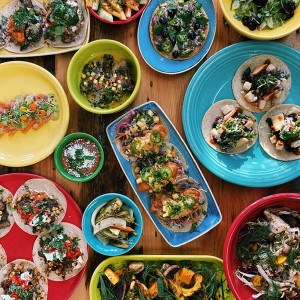Supply Chain: Winter Edition

From left to right: Pat Woodbury, of Woodbury Clams; Eric Morris, of Red’s Best; and John Lee, of Allandale Farm.
Winter’s a bitch, you guys. Sure, the snow is pretty as it flutters down in perfect geometric mini-crystals, and sledding’s kind of fun, and okay, we love any excuse for drinking our weight in mulled wine (thank you, polar vortex). But when you’re cautiously skating across the frozen brick sidewalks like a baby giraffe—or digging your car out for the third time this month—you find yourself cursing the icy weather-laden skies and attempting to warm up your toes by stomping around like a crazy person.
Even so, for most of us, winter is walk in the park compared to winter through the eyes of our hard-core local farmers and food purveyors. They are the ones most intimately aware of what winter truly means—every frostbitten edge of it. We revisited some of our favorites from the summer to see how the annual New England slush is treating them.
‘Tis the Season: “Winter is my summer vacation! We harvest up through New Year’s. Things get difficult out on the flats this time of year, because where we grow—and in most of Wellfleet—is intertidal. We get ice and the temperature makes it difficult, so we stop, and we’ll be off until spring. It’s a unique time of our season. The first month we pick up the pieces that we’ve left during the season, try to figure out where we are and analyze how the year went and what our next move is. Another part of our business is research and design, so during the year, we got a grant to design a clam-sorting machine. We built it and tested it, and over the winter we’re going to be rebuilding a machine we have in our shop that sorts sizes of clams, and then build a clam-counting machine. Fun stuff like that.”
The Clams Call the Shots: “The reason we traditionally stop after January 1 is probably more to do with the shellfish than us. We get used to the cold during the fall…even though you do freeze out there. At water temperatures in the mid-30s, the clams and oysters become dormant. They’re not really moving or feeding. What happens with clams is they dig a little deeper into the sand, but if you disturb part of the bed and maybe harvest part of it, then you have all these clams that are lying out on the surface and can’t dig themselves back down and they freeze. It ends up being a challenge and you lose a lot of stuff if you mess with it this time of year. The strategy for most growers is you sell everything you have that’s legal, and then you bring in everything that’s sublegal. What you can do actually is bring it into a root cellar, and they’ll survive for two months in a root cellar if you keep it at a constant temperature. When they’re closed and dormant, it’s like they’re bionic! They can survive almost anything.”
Don’t Ever Let Go, Jack: “Winters are different every year, and we’ve had ones where we never got any ice and extreme ones where all of Wellfleet Bay as far as the eye can see is frozen and locked in. On our bed I’ve had icebergs that were 10 feet big! That’s when the seawater freezes and the tide moves it so you get these layered icebergs. You always say, there’s just no way anything’s alive under there!’ But we’re usually pleasantly surprised after it melts.”
‘Tis the Season: “The workload shifts from sales to building the business. We close on December 23, and don’t reopen for another 90 days. During that period, we build programs, we fix all the things we’ve broke in the summer, and we look at new products. We’re always looking for new products, but now we really have time to think about what we want to do next year. And we shovel snow, of course. It’s a quieter time, but it’s not a lot less busy. People come and go and people’s work hours average out—so the people who work 70-80 hours a week in the summer work about 20 hours in the winter.”
Downtime (or not): “We take time off and go do things with our families, or go somewhere, or read a book or watch television for once! I’m trying to muddle through a bunch of books, but if I turn on the television I fall asleep. Mostly, I just keep going all winter. I like my rut! If I get out of it, I get lost.”
Winter Bestsellers: “Definitely all the root vegetables…potatoes, onions, carrots, beets…and some leafy greens. Those are the big sellers right up into December.”
Eyes to the Skies: “We need snow really badly this year. The rain we had the other day was helpful, as ugly as it was. The ground is really dry, and we need groundwater really badly. A nice snowpack that doesn’t go away would be terrific. Or some nice warm rain. I’d take that so I didn’t have to shovel it!”
‘Tis the Season: “Traditionally, winter’s a little bit slower for us, but over the last few years it’s been really picking up. This year we’re getting wild oysters off the Vineyard, bay scallops, and then some really great stuff out of Chatham. Weather’s always a factor out here, but we have a few boats that keep at it, so it stays pretty busy, weather permitting.”
Winter Bestsellers: “Monk and skate are both really big this time of year, and the in-shore cod fishery really comes to life because the imports aren’t as strong. It sucks when you get this really gorgeous local cod, but it’s affected by global supply from Iceland and Norway. This time of year, we can get prices that can keep those guys going…every month is a little bit different. I always look forward to oyster season and live scallops are just coming in.”
Challenges: “Sometimes people have got to understand that we are a day-boat local fishery, and when the waves are at 10-15 feet and the wind is crazy, it’s not safe for guys to go out and we’re not going to have product. The price is obviously high because no one went out. It’s a very dangerous profession for a reason! Nor’easters happen this time of year, so there are going to be weeks when there’s nothing.”
Final Word: “I always try to stay positive about it. It’s winter, you’re going to have storms. We know this, we prepare for it. Hurricane Sandy was probably the last thing that really made it challenging for us.”


